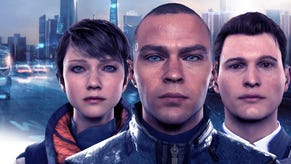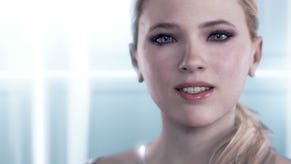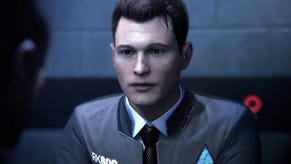Detroit: Become Human is a different kind of tech showcase
What happens when advanced tech, talent and budget is deployed on a more focused experience instead of a giant open world?
As big budget triple-A games fixate increasingly on delivering larger, more complex open worlds, we're left wondering - what if all that power was concentrated instead into smaller scale environments with a focus on extreme detail? That's exactly the approach we see with Detroit: Become Human, with developer Quantic Dream delivering its best game yet - and a polished, intricate presentation quite unlike anything else seen on the market today.
Detroit is built on the latest iteration of Quantic Dream's in-house engine, and it's the first original PlayStation 4 title released by the studio. However, its concept is rooted in a 2012 technical demo presented at GDC known as "Kara", which was designed for PlayStation 3. This demo serves as a teaser for what would become Detroit, while acting as a reference point of sorts for how the technology would evolve over the coming years. It still looks good but the final game is a significant leap beyond that initial demo.
At its core, Detroit shines brightly on both the PlayStation 4 Pro and the original PlayStation 4 console. When using a Pro, Detroit makes use of checkerboard rendering to reach a 2160p pixel count, but many of its post-processing effects are rendered at lower resolutions to save on performance. On the base system, Detroit instead offers a full 1080p image. Both versions make use of an extremely high quality eight-tap temporal anti-aliasing solution, in order to eliminate edge shimmer and in-surface aliasing - Quantic Dream reckons the fidelity holds up against 8x MSAA. It requires just over 1ms of processing time from the game's 33ms per-frame render budget, making it an effective and fast solution.
In practice, the game's focus on post-processing actually makes the difference between the two more difficult to pull out in motion - there can be variations in aspects like volumetric light resolution, but side-by-side, both versions look extremely similar. Based on what we've played so far, PlayStation 4 Pro's biggest advantage seems to be performance-based - there are occasional fluctuations under the 30fps level on both systems, but the Pro generally loses fewer frames, while the taxing more open areas see a more profound advantage for the enhanced hardware. The bottom line is that resolution isn't a crucial component of the presentation overall, and both PlayStation consoles deliver a beautiful look.
Quantic Dreams' objective was to create an engine that could support a variety of unique environments with lots of dynamic lights, along with variable weather conditions such as rain and snow and advanced direct and indirect lighting. According to the studio's GDC presentations this year, the latest iteration of its technology utilises clustered forward rendering - an approach that offers many of the advantages associated with forward rendering including a single pass for geometry while also handling many dynamic lights. Standard forward rendering requires lighting calculations to be performed on every visible vertex and fragment, making it computationally expensive to render lots of dynamic lights. By breaking the scene into clusters instead, however, it becomes possible to render more lights within the strict render budget.
While exploring the game, there's a genuine sense of realism on display but just how is this achieved? It's a complex question, but one key element lies in its materials systems. Detroit makes use of physically-based rendering to properly simulate roughness and reflectivity of light across materials. When light reflects off surfaces such wooden floors, fabrics or drywall, it dissipates across the surface, while shiny metals or wet pavement present tighter reflections - just like real-life. And all those little imperfections and microscopic abrasions present across real-life surfaces? The utilised BRDF (bidirectional reflectance distribution) ensures that these accounted for. Light also respects the laws of physics thanks to partial energy conservation - which basically means that the reflection of light cannot exceed the brightness of the original light source. All this is to say that like other PBR models, materials are designed to react naturally and realistically to incoming light sources.
Every environment in the game is lit using a mix of dynamic lights, which are lights which can be moved around the scene, and baked global illumination data. The question is - what does this mean for the player? Put simply, lighting looks fantastic. The game sends you through a wide variety of areas and this approach to lighting boosts realism across the board, while allowing Quantic's artists to present even more striking scenes. When exploring Todd's filthy hovel early in the game, the area is predominately lit indirectly, but it appears strikingly realistic in practice. Other areas - those set outdoors, for example - appear far more vibrant with bright lights and reflections everywhere.
By limiting the scope of the game to specific key areas, however, Quantic Dream can focus more of its time and effort into creating much richer scenery. Many of these features are present in other game engines but it's the coupling of excellent lighting with carefully modelled and textured scenery that makes all the difference. There are certainly open city areas in Detroit and they showcase the engine at a larger scale, but it's often the more confined spaces which impress the most.
Another key element in the presentation is character rendering - after all, this is a story-driven game and you'll be seeing a lot of close-ups of each major character in the game. Detroit makes use of extremely high polygon character models that are all superbly shaded, textured and animated. High quality models have become increasingly common but even then, Detroit reaches new heights.
When examining a digitised actor, we tend to focus first on the eyes - and Detroit offers a good solution here with a bespoke eye shader and movement mapped to the performance capture data. As a result, in most scenes, the eyes no longer have that dead look you may remember from Heavy Rain. Even more interestingly, there is a unique, perceptible difference between androids and their malfunctioning counterparts, dubbed the 'deviants'. When the androids are acting within their programming, there is a sense that the eyes of these machines appear slightly less realistic than the humans around them. As they take on more human attributes, however, it seems to slowly change.

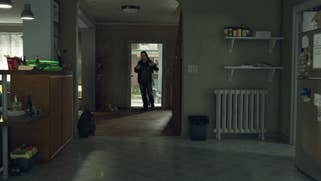


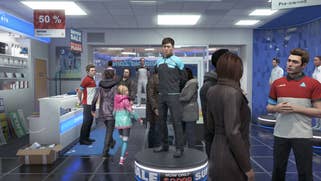
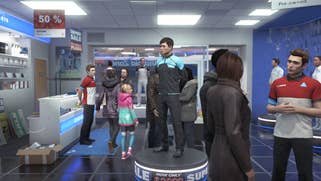
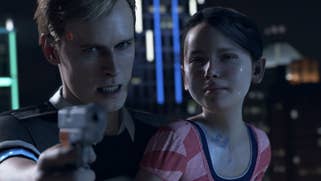

Then there is the surface of the skin. A screen-space sub-surface scattering technique is used to simulate light penetration across the skin and is used heavily throughout. This allows light to penetrate and dissipate throughout the skin and fat of the digital actors. When you hold your palm up to a bright light and see a pinkish glow around the edge of your hand, that's subsurface scattering in action. Hair is another key element which is always difficult to render but the selected technique generally produces excellent results, and Quantic Dream has also made a good effort here in animating hair depending on conditions. This extends to cloth rendering on costumes, which possesses a realistic simulation model reminiscent of Assassin's Creed Unity. It looks excellent in motion. The dedication to achieving a realistic look even extends to the mouths and teeth of the characters - again, the lighting is spot-on and remarkably authentic.
Cinematic sequences are further enhanced by a combination of close-up lighting and shadows. When engaged in conversation, secondary lights are used for each character, enabling them to stand out in each scene - like using a studio light while filming a subject in real-life. Objects within a 10 metre radius also receive an additional close-up shadow, which basically means that objects within this area produce cleaner, more defined shadows. This helps avoid the typical shadow artefacts you might otherwise encounter.
Character models have always looked great in Quantic's games but it's the animation and performance of each digital actor that really stands out. The studio uses a full performance capture rig to bring the actors and actresses into the virtual world to great effect. The team first utilised this with Beyond: Two Souls but the more realistic rendering available in Detroit increases the realism significantly. These characters are further highlighted by the excellent bokeh depth of field - basically, the circular shapes visible in out of focus regions. This is a natural occurrence that can be produced using the right lens with a camera and the shapes presented here add to the cinematic presentation.
And really, with Detroit, it genuinely feels as if the developers were focused on simulating a real camera within a virtual world. The concept of 'interactive cinema' has been around for many years, as has post-processing designed to simulate camera behaviour, but Detroit goes one step further. It genuinely feels as if it were shot more like a film than a game. The angles, cuts and camera tricks all manage to create this feeling and depth of field is just one element of the presentation.
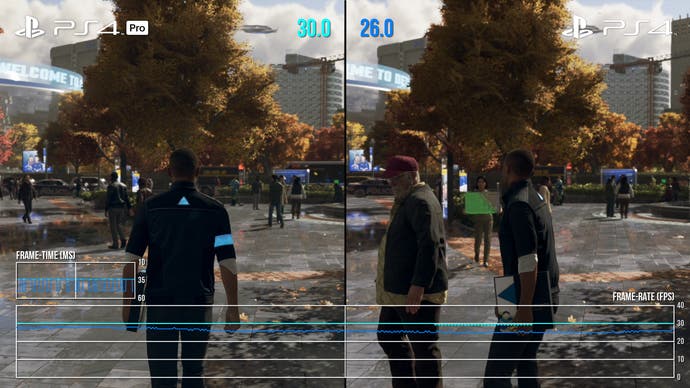
Per-object and camera motion blur are other key components used to further the sense of realism. The intensity of motion blur in filmed footage varies based on the selected shutter speed of the camera and virtual shutter speed must be considered when replicating this effect in a game. Detroit uses an agreeable shutter speed that looks suitably filmic, but manages to avoid obscuring the detail present in the image. Like most post effects in the game, motion blur is rendered at half resolution to save on performance, but it still manages to impress.
Another element that supports this idea of a virtual camera is the film grain featured throughout many sequences - darker scenes, which would naturally require a higher ISO with a real camera, exhibit noticeable grain while brighter, more exposed scenes are much clearer. When these camera effects are combined with the advanced rendering pipeline, the results appear quite striking. Of course, there's still more to building atmosphere than camera and lighting tricks alone. One crucial aspect in boosting the sense of realism lies in the use of volumetric lighting, which Detroit relies heavily to build atmosphere. These volume lights are temporally filtered and avoid leaking artefacts as well.
Cascaded shadow maps are also beautifully rendered, using temporal super sampling to present clean, smooth edges while jittering is combined with the temporal anti-aliasing to enable smooth transitions between each split. Many light sources can cast dynamic shadows as well. Then there are reflections. The forecast regularly calls for rain in Detroit, so wet surfaces play a significant role in the presentation. Reflections are handled using a mix of cube-maps and screen-space reflections. These reflections are rendered at a reduced resolution but filtered and displayed in such a way as to deliver clean, defined reflections. Screen-space reflections are a key component in many scenes, especially when rain or snow is involved.
Speaking of which, Detroit features some of the finest weather effects we've seen in any game to date. Rain is a difficult effect to get right, but this engine produces beautiful results. Between the droplets and water spray itself, to the gorgeous water shaders used across the soaking wet city, rain plays a huge role in establishing atmosphere and it just looks remarkable. These weather effects play a key role in establishing the mood necessary to tell the story. Can you imagine Blade Runner without rain? If these effects were implemented poorly, the entire mood may have been spoiled - but Detroit pulls it off.
But it's the way that Quantic Dream's refined engine achieves its results that truly impresses. We've examined many beautiful games over the years but if you look closely enough, there are usually minor faults to be found. That's not really a feeling we get with Detroit generally. While the vision is more limited in scope, it feels as if every element of the presentation has been executed almost to perfection. The 'ground rules' of reality are observed, from the correctness of lighting to weather conditions to animation - and the interplay between all of these elements is pitch perfect.
Another important consideration here is how smoothly Detroit transitions between each scene. Loading screens can ruin pacing but during normal gameplay, the new game manages to keep them to a minimum. By moving necessary assets in and out of memory at strategic moments, Detroit jumps between entirely different locations without a hiccup - like a movie. In previous games, such as Beyond Two Souls, players could be left watching a loading screen between each major scene, which only served to slow down pacing. By solving the issue entirely, the experience ends up feeling more cohesive.
And that's a perfect description of the game presentation as a whole - cohesive. From its rendering to its acting and cinematography, it's fair to say that Detroit has raised the bar for this type of experience. Narrative-driven games have become increasingly popular over the years with titles like the excellent Life is Strange and all the various Telltale games, but most of them are built with a smaller budget and a shorter development time. Quantic's latest effort demonstrates what can be achieved in this space with more time and a significant budget.
It also highlights just how much the team at Quantic Dream has evolved over the years. There was always a certain ambition in its narrative-driven games but each one ultimately falls short in key areas - whether it was performance problems, weird presentation quirks or unsatisfying conclusions, the result was never quite what we had hoped. With Detroit, it finally feels as if the team has achieved what it set out to do from the beginning. It's a beautiful, polished game that perfectly combines its impressive, enhanced in-house engine with brilliantly realised art. It's not a game for everyone - at its heart it is still very much a Quantic Dream game with much of the baggage to match - but it is a unique technological statement, and a strong, compelling evolution of the studio's formula. And most importantly of all, we had a great time playing it.







